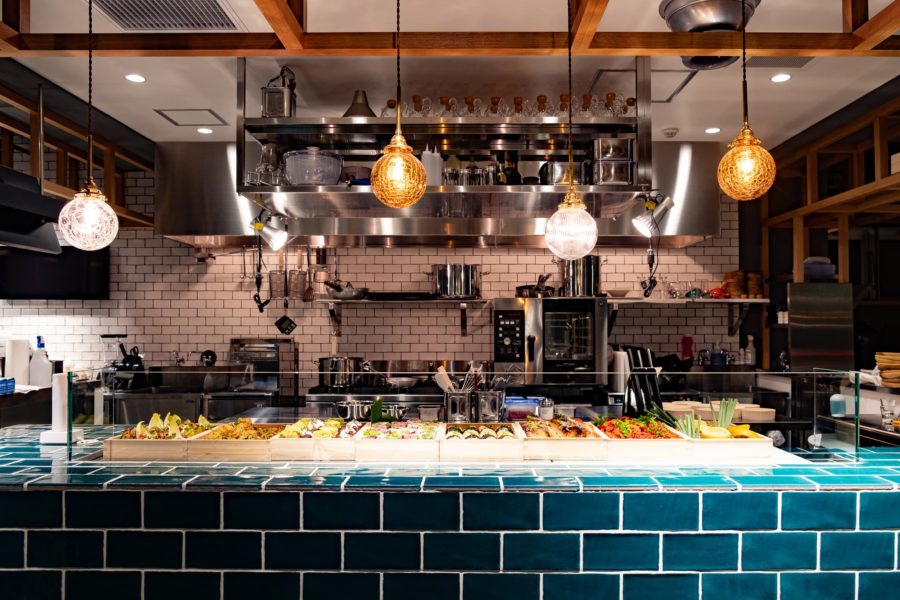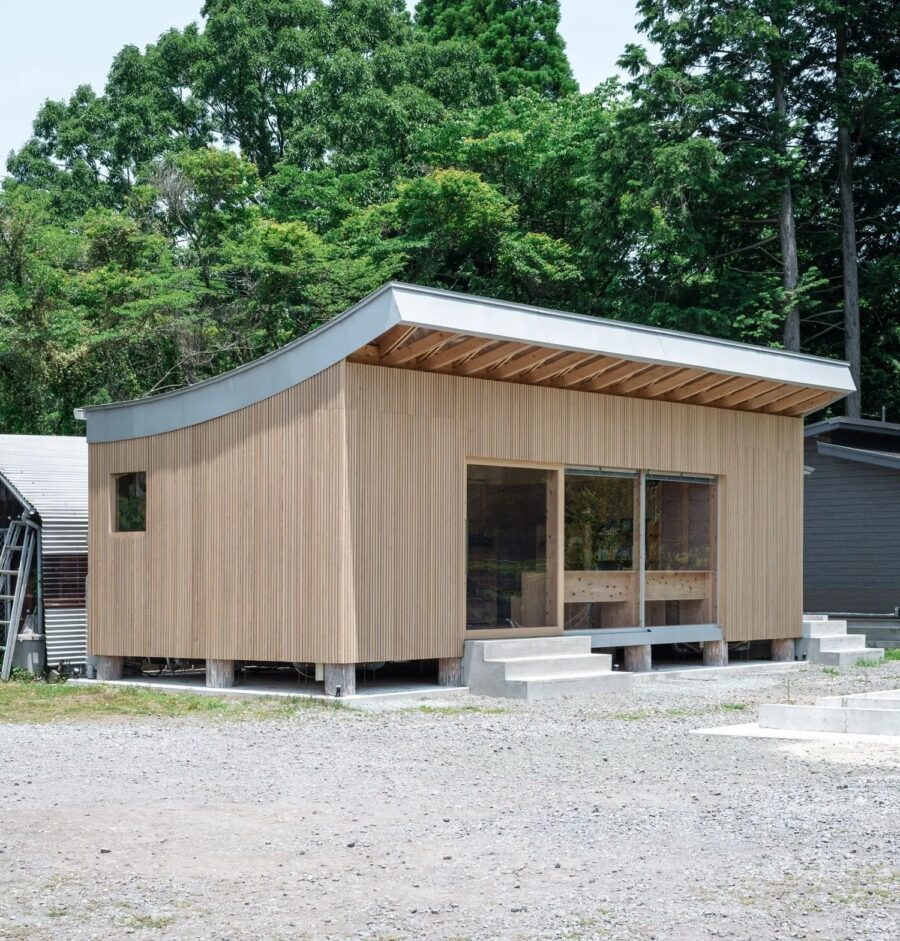過去と現在をつなぐパティオのリノベーション
タパス系レストラン、”La Bona Sort”(カタルーニャ語で「幸運であれ!」)はバルセロナの旧市街であるボルネ地区のカルデラス通りに面しており、昔ながらの切り石構造でつくられたファザートが特徴である。
このボルネ地区は16世紀の歴史的文献に基づくように、当時の貴族の宮殿など歴史的背景が多く残されており、このカルデラス通りも歴史的背景の一部として知れ渡っている。この通りは元来、山の方面の街を通り、バルセロナを通過し、さらに海の方面の街まで続く旧歩道であった。この道の中心部分にラ・ボナソルトは19世紀に誕生したのである。
当初、ラ・ボナソルトは家族経営の民宿として経営をしていた。このカルデラス通りには馬車も通り、バルセロナを往来する使者などの伝達配達人、さまざまな旅人の憩いの場所として提供されていた。その後、宿屋からワインカーブに変化した。この時代の流れが現在のレストラン、ラ・ボナソルトの基盤となった。
現在ではワインを中心としたタパス系レストランへとして経営している。このレストランは家族経営であり、現在は3代目が仕切っている。建物自体も16世紀の面影として、ホテル経営をしていた時代、そしてワインカーブ時代の歴史的名残が、中庭、中2階、そして馬小屋として使用されていたアーチ型のアーケード部分など、あらゆる部分に歴史的時代の面影を垣間見ることが出来る。
ジョルディ・ジナブレダ・インテリアデザインではこれまでの歴史背景をレストランのデザインの方向性を決定づけるものと考え、徹底的に研究し、昨年度はレストラン内部のリノベーションを実行し、今年は外部に位置するパティオ(中庭)の部分を実施した。この歴史的背景を考慮に入れ、コンセプトを“中世から現代へのアクセス” と決定した。
リノベーションの第1段階として、レストラン内外の10年以上放置されたオリジナルの石材壁を綺麗にすることからはじまった。
昨年度のレストラン内部のリノベーションは内部の3つのアーチ型のゲートで空間の役割を区別するようにデザインした。つまり、エントランスからカウンター席、1つ目のベンチとたくさんのペンダントライトで構成された食事席、もう1つの食事席とに区切り、それぞれの特徴を生かしながらレストラン全体としては統一性のあるデザインをした。素材は元来の石壁にふさわしいようにオークの古材を使用し、さらに壁面にはさまざまな植物が備え付けられている。ライティングは、19世紀に旅人が実際に経験したであろう淡い間接照明をふんだんに使用した。
今回のメインのリノベーションは、レストランの外部パティオである。レストラン内部と外部はレンガ造りの巨大なアーチで隔てられ、一歩外へ踏み出すと、床材にオリジナルの石材を使用したテラス席が続いている。
パティオのテラス席は、合計300㎡の3つの異なるパートで構成されている。
まず、外部に出て左側に見える空間はレストランの敷地外へ続く出口部分で、パッサージュのかたちをしている。ここは元来、この建物の主要エントランスとして16世紀に使用されていた場所である。
統一性のある空間とするために、店舗内部と同様にオークの古材を使用し、壁面にはさまざまな植物を配した。照明も内部と同様に、淡く優しい色合いで灯すLEDの間接照明を設置したほか、天井にはいくつものボール状の電球色LEDグローブストリングライト、そして壁にはフランス製アンティークのジェルディ社のウォールランプを設け、旧き良き時代の面影を現在の空間へと照らし出す。
2つ目の空間はテラス席を離れると真正面に出くわす空間である。この部分は天井に多くの植物が吊り下げられ、壁面には植物が垂直に覆っている。ベンチ席にもまた、レストラン内部と同様にオーク古材が使われている。この空間にも間接照明を用い、さらにテーブル席をよく照らすために幾つものペンダントライトを使用している。
最後の空間は、先の2つの空間とは異なる、大胆で斬新なデザインで仕上げられている。最も目を引くのは、モミの木の合板でつくられた2つの大きなボックス「プライベートキューブ」である。ブルーに塗られたこれらのボックスは石畳の床から10センチ浮かせ、宙に浮かんでいるかのようにした。ボックス内のランプには、モダンなウォールランプを使用。天井からは無数の縄が吊り下げられている。
外部空間の中心に位置する石畳空間の家具の選定では、クライアントからの要望で流行を取り入れた。チェアはポップでさまざまな色の製品を選び、テーブルにはヨーロッパならではの昔ながらの大衆食堂をほうふつとさせる、大理石と鉄で出来たレトロなデザインを用いた。照明は暖かみを持たせるボール状の電球色LEDグローブストリングライトを天井から吊るし、デザイン性の高いライトを使用している。
バー&レストランとなったカタルーニャのこの建物とパティオでは、過去と現在が握手を交わして未来を見つめている。そして昔と同じように、今でも旅人をはじめ人々がバルセロナとの行き来の絶えない喧騒のなかで、居心地の良い避難所を得る場所となっている。(ジョルディ・ジナブレダ)
Patio renovation that connects the past and the present
“La Bona Sort” tapa’s restaurant is sited in an old manor house documented since the sixteenth century; a large ashlar work frontage that overlooks Carders street, the old road from Barcelona to the Vallès county. Because of its privileged location, between Born and Santa Caterina districts, the building soon became a well-known hostel, “el Hostal de la Bona Sort”, departure point for stagecoaches and couriers and accommodation for travellers bustling from and to Barcelona. After that, it was occupied by a bulk wine shop first, and a restaurant then, which has made it to present days run by the third generation of the same family. It preserves the typical Catalan hostel structure: a big courtyard, its attic and the stables.
All this historical record was determinant when Jordi Ginabreda interior design studio took care of the project for updating the appearance of the courtyard of the place. Nowadays, the business is located in the old stables and it extends through the old hallway and courtyard its huge partially covered terrace. A series of ashlar work and brick diminished arches link up both the inner space and the different parts of the courtyard. The sixteenth century stone walls and arches are the perfect backdrop in a proposal that centers its strategy in covering the whole place with a sort of old patina giving it a sense of antiquity. A travel to the present departing from the rich history of the place.
The first step of the refurbishing consisted in cleaning up thoroughly the original stone walls after decades of neglect. A huge brickwork arch allows the access to an open air patio from where you can get to the three different porches, each one with its own identity, which form the terrace of the restaurant. The same vocabulary, shared with the covered part of the restaurant, defines the whole proposal. The original stone pavement works as a visually unifier for the several covered and uncovered spaces that shape the 300 square meters of the courtyard.
The old entrance from the street is now occupied with a covered corridor that can be seen from the outside. Its walls are covered with the same layer of aged oak wood that line the main interior dining area creating a bond between the two spaces for the passers-by. Mosses and lichens grow on these walls, as an echo of years of dampness and closure. Dim lighting and the inclusion of old rickety Jieldé lamps recrafted specially for the occasion complete the dialogue with the past.
At the back of the terrace, the patio opens to two more porches. One of them takes to the limit the years of abandonment concept. Mosses and lichens grow out of control here, conquering a whole wall and hanging brutally from the ceiling. A perimeter aged wood bench completes this area.
The other porch is placed in the old warehouse. The ropes that once tied luggage and cargo to the carriages dangle now from the roof creating a texture that not only gives the place a distinctive atmosphere but also helps to hide the technical installations. This part of the terrace, that in the past was plenty of boxes containing the goods of travelers and traders, is now filled with two big containers, two huge cubes lined with three layer fir wood and lacquered in matt blue. They house a table and two benches. These big sort of private rooms seem to float over the stone pavement, help to define the space and become, without a doubt, the most audacious proposal of the whole project.
This journey that leads us to the present couldn’t obviate today’s language which is strongly shown up in the choice of furniture and lighting elements. The heterogeneous mix of contemporary chairs (including He by Hay & Form Chair by Normann-Copenhagen) in different colors and tables with varied material finishes help to emphasise the jumbled spirit of and old working class tavern. The illumination of the different areas, in deliberate warm tones, includes indirect lighting with LED, Disc and Sphere Wall Light by Areti to light the “private-cubes” and Lambert’s Switch On floor lamp.
Past and present shake hands to face the future in this old Catalan hostel turned into a restaurant. A place where nowadays travellers, as those in the older days, find a cozy shelter in their never-ending bustle from and to Barcelona. (Jordi Ginabreda)
【タパス・ボナ・ソート】
設計:ジョルディ·ジナブレダ スタジオ
主用途:バー、レストラン
所在地:スペイン バルセロナ Carrer dels Carders, 12, 08003
オープン日:2016.2
竣工:2016.2
インテリアデザイン・監理:ジョルディ·ジナブレダ / ジョルディ·ジナブレダ スタジオ
床面積:255.54㎡(パティオ部分のみ)
席数:120席(パティオ部分のみ)
設計期間・工期:2015.02-2016.02(パティオ部分のみ)
写真:マルセラ・グラシ
■主な家具と照明器具
[家具]
– He / Hay
– Form Chair / Normann-Copenhagen
[照明器具]
– ブラケットライト:Disc and Sphere / Areti
– フロアランプ:Switch On / Lambert
【TAPAS BONA SORT】
Architects: Jordi Ginabreda Studio
Principal Use: Bar & restaurant
Location: Carrer dels Carders, 12, 08003 Barcelona, Spain Year: 2016.02
Project team: Jordi Ginabreda -Interior design
Area: 255.54m² (only patio)
Period of project and building: 2015.2-2016.2 (only patio)
Photographs: Marcela Grassi
Main furniture & Lump
– He / Hay
– Form Chair / Normann-Copenhagen
– Disc and Sphere / Areti
– Switch On / Lambert








